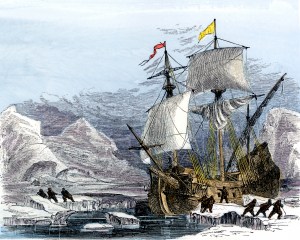
Willem Barents expedition in the 1500s searching for a northeast passage. (AP)
I went to an interesting talk today in Hong Kong where Felix Tschudi, the chairman of the Tschudi Shipping Company in Norway, raised an interesting proposition: What if the shipping industry’s pirate problem could be solved by our warming planet?
In 2010, Tschudi starting working on a plan to start shipping iron ore from Kirkenes in the far north of Norway, where his company owns a mine, to China, the mine’s largest customer. The route he wanted to use is known as Northeast Passage, a path that meanders from northern Europe east along Russia’s vast north coast and through the Bering Strait, before making a right turn south. Explorers have tried to find a viable way through this short route from Europe to Asia for centuries, with varying degrees of success.
Why try again now? The reasons the shipping magnate cited for looking into the voyage today are compelling: the summer sea ice along the route is at a historic low, technological advances in ships have made the trip feasible, commodity prices are sufficiently high that more sources and cheaper routes are needed, and, perhaps most importantly, “Russia is interested.”
With Russia’s help, Tshcudi’s firm successfully completed the trip last summer. One of their ships, loaded with 100,000 tons of iron ore, was accompanied by a Russian nuclear icebreaker for the journey. Technically, the icebreaker wasn’t needed; the ice is so sparse now in the Arctic summers that the crews only encountered drift ice along the way. But ‘renting’ a Russian companion is part of the deal for any commercial ship wanting to make its way through those waters. In 2009, when two German ships were the first commercial vessels to successfully use the northeast passage, they, too, had a Russian host.

The Northeast Passage (blue) and the traditional shipping route through the Suez Canal (red). Courtesy of Wikipedia.
Tschudi says that while the cost of using this route ended up being comparable to the longer route through the Suez Canal, the company saved both time and fuel on the journey, and, of course, avoided the piracy in the Gulf of Aden that has been getting steadily worse since 2008. Piracy cases have continued to increase despite efforts of shipping companies to secure their ships while passing through the region; last year, a record 1,016 crew members were taken hostage, up from 867 in 2009.
“Do I think it will change everything? No,” Tschudi said of the north sea route today. But, he says, it does offer an option, as well as an opportunity for specialized vessels that could, for instance, start making shipments via rivers in Siberia where road transportation has long been a problem due to permafrost melt in summer.
It’s an interesting development considering the geopolitical posturing happening in the North Pole back in 2007. That August, two Russian submarines descended nearly two miles below the North Pole’s ice cap to plunk a flag on the ocean floor and stake claim to their share of untapped oil and gas that experts believe are in the region. The move, which not coincidentally took place during the first summer season in which the Northwest passage near Canada was free of sea ice, sent Canada, Denmark and the U.S. into a frenzy to map out their competing claims to Arctic territory. Since then, the level of international cooperation in the region has improved; today, ministers from all nations with Arctic territory, including U.S. Secretary of State Hillary Clinton, are meeting in Nuuk, Greenland, where they are expected to adopt a treaty on Search and Rescue procedures in the region. (See TIME’s 2007 cover on the rush for the Arctic.)
“[The Russian government] want this to happen and they realize it’s in their interest to have people using the passage,” said Tschudi. “It brings down costs for everyone.” Part of the economic incentive for Russia is that the business could help pay for the upkeep of the nuclear icebreakers that have been companions to the first of the commercial traffic. The state-owned fleet, designed for winter use, doesn’t have much else on their plate during the summer months, and this would be welcome source of income in a swath of the map where economic opportunities are lacking.
Whether companies will join Tschudi and decide that it’s worth the trouble of paying a Russian escort to use the Northeast passage instead of risking the well-worn pirate-infested waters outside the Suez canal remains to be seen. While the costs are comparable, the devil shippers know might be more appealing. Even Tschudi, who said his experience working with Russia on the project was positive, admitted that “Russia is perceived is a jungle. And of course,” he added, “It is a jungle.”


